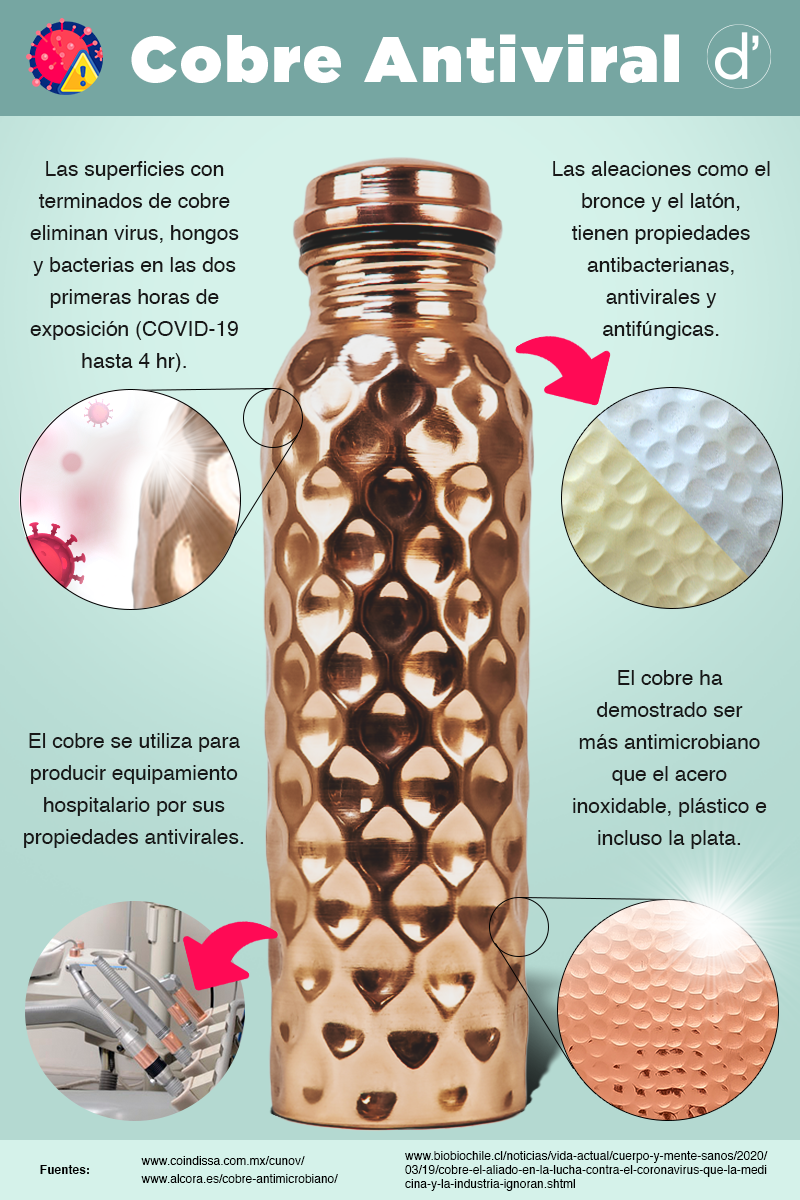
ANTIMICROBIAL COPPER
Share
Did you know that #copper is a metal that has many wellness characteristics?
In addition to being a metal used in industry for its conductivity, malleability and beauty, not to mention its ease of fusion to create high-value alloys such as brass and bronze. But these are not the only uses that humanity has given to such a precious metal. For millennia, copper has been an ally when it comes to combating the transmission of diseases, although medicine and industry seem to be unaware or ignorant of its antimicrobial properties. , which could help in the current fight against new viruses and bacteria.
There are several sources that we can mention that have investigated these properties, recently the VICE magazine published about the history of the use of copper for health, in ancient Mediterranean cultures it was important in the manufacture of utensils, weapons and other instruments.
In ancient Egypt it was used to sterilize wounds and in utensils for drinking water, both copper and its alloys have played an important role in the development of humanity.

source: https://franciscopereira81.wordpress.com/2014/02/04/tecnologia-del-antiguio-egipto/
Today, the world is experiencing an epidemiological crisis that generates great uncertainty about how to prevent contagion. We are referring to COVID-19, a new virus that emerged in China at the end of last year and has spread to most countries. , this has generated panic among the population. In this article we present information about the antibacterial properties of copper and some uses that have been given to it around the world.
Antimicrobial Copper is the only material approved by the US Environmental Protection Agency (EPA) that continuously inactivates organisms that settle on its surface. It has been shown to be effective against viruses, fungi and 99.9% of bacteria in the first two hours of exposure. Various studies and tests have proven a higher antibacterial effectiveness than other surfaces with stainless steel, plastic and even silver finishes.

In another study it was found that bacteria depend on metals such as iron or calcium to obtain the energy necessary to survive; copper, in addition to not “feeding” them, effectively eliminates them due to the so-called “contact death” in which The bacteria lose their biological abilities to survive.
In some countries of the world, in public places where a large influx of people attend, such as train and bus stations, airports, educational centers, sports centers and municipal facilities , the use of antimicrobial copper has been incorporated and mainly in those places where hygiene is especially important. important, such as hospitals and educational centers.

source: https://invdes.com.mx/innovacion/las-camas-de-cobre-del-hospital-matan-bacterias-y-salvan-vidas/
Various public and private entities around the world have made the commitment to incorporate antimicrobial copper surfaces in the facilities they manage, with the aim of caring for the health of their users and employees while encouraging the expansion of these measures to other places. . The municipalities of Bezannes in France and Vari-Voula-Vouliagmeni in Greece, or the Alameda station in Santiago de Chile, are good examples of this.
A clear example of this use of copper is the Alameda bus station located in the city of Santiago, Chile, which is the main means of transportation for more than ten million people. With this influx of people, the most frequently touched surfaces in the station are prone to becoming contaminated with germs that can survive for days, weeks, or even months.
TurBus, the company that manages the Alameda station, has installed copper plates on the counters and trays of the ticket booths as a protection measure for its workers and customers, thus improving the service offered from the moment of ticket purchase. This is the first bus station in the world to take these types of measures against the spread of infections among the general public.

source: https://copperconcept.org/es/rereferences/aeropuerto-de-congonhas-brasil
In countries such as Germany, Chile, the United States and Spain, some companies began to use copper to produce hospital equipment such as IV poles, handrails, beds, handles, bathrooms and sinks, among others.
In Chile, the CUNOV company has developed an economical way to incorporate antimicrobial copper in public places and hospitals in the form of copper sheets that adhere to the surfaces of tables, handrails or some other place that may be vulnerable to the development of bacteria, viruses. and mushrooms.
In Mexico, unfortunately, the necessary support has not been given to the use of copper in hospitals and public places because the cost of furniture is high compared to stainless steel or other materials.
Although surfaces with copper finishes are an excellent ally against viruses, fungi and bacteria, continuous cleaning should not be neglected, nor should good hygiene practices such as washing hands continuously, especially when having visited a public place, using antibacterial gel and if you suffer from a respiratory illness, cover your nasal and oral cavities correctly as well as not forgetting to cover your forearm when sneezing, all of these measures prevent the risk of contagion.
To maintain the shine of your products in bright color, just clean with lemon and carbonate, then scrub with green fret fiber and if you want more shine use some metal polish
SOME IDEAS OF USE

